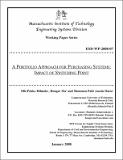| dc.contributor.author | Hilmola, Olli-Pekka | |
| dc.contributor.author | Ma, Hongze | |
| dc.contributor.author | Datta, Shoumen | |
| dc.date.accessioned | 2008-08-01T15:47:35Z | |
| dc.date.available | 2008-08-01T15:47:35Z | |
| dc.date.issued | 2008-08-01T15:47:35Z | |
| dc.identifier.uri | http://hdl.handle.net/1721.1/41918 | |
| dc.description | Current tools of operations management do not offer insight for advanced decision making. One potential method for tracking
these signals may be the development of the GARCH technique (proven useful in financial risk management and awarded the 2003 Nobel Prize in Economics). Improving precision in predictive analytics may help in better execution of the switching point decision making (among other things) for much larger and more complex operations with vast number of decision parameters. The incorporation of ambient intelligence or algorithms from artificial intelligence may help purchasing
systems learn how to be autonomous and/or help human operators to decide between portfolio of approaches by evaluating decisionable information extracted from data analytics (acquired from a plethora of business processes). Taken together, these represent potentially interesting future steps. | en |
| dc.description.abstract | In operations management different ordering policies, such as, economic order quantity, lot for lot and periodic ordering, are used in various combinations without deeper considerations for the likely consequences on cash flow and profitability. The success of these techniques is analyzed through
inventory levels and/or total cost. In this paper, we present results of simulation which uses three different product groups with varying demand characteristics, changing product margins and also
considers product quality failures (due to ordering, engineering change or customer requests). Based on our results, we suggest a portfolio approach where lot for lot policy may be useful in an early phase of the product life-cycle and later it may be an advantage to change over to economic order
quantity (EOQ) based ordering. However, demand sustainability and failure rates create instances where orders in larger economical lots may reduce profitability. Therefore, manufacturing may benefit from a portfolio of different purchase order policies and may evaluate the successful balance of policies using cash flow as a parameter. Accuracy of demand forecasting is vital to switching point estimation. Further research on real-world applications of advanced forecasting tools is advocated as well as a framework to develop the portfolio for intelligent purchasing systems. | en |
| dc.description.sponsorship | Lappeenranta University of Technology (Finland), Accenture (Finland) and MIT Forum for Supply Chain Innovation http://supplychain.mit.edu/shoumen | en |
| dc.language.iso | en | en |
| dc.subject | Lot for lot, EOQ, mixed ordering policy, life-cycles, cash flow, VAR, GARCH, RFID | en |
| dc.title | A Portfolio Approach for Purchasing Systems: Impact of Switching Point | en |
| dc.type | Working Paper | en |
| dc.contributor.department | Massachusetts Institute of Technology. Auto-ID Laboratory | |
